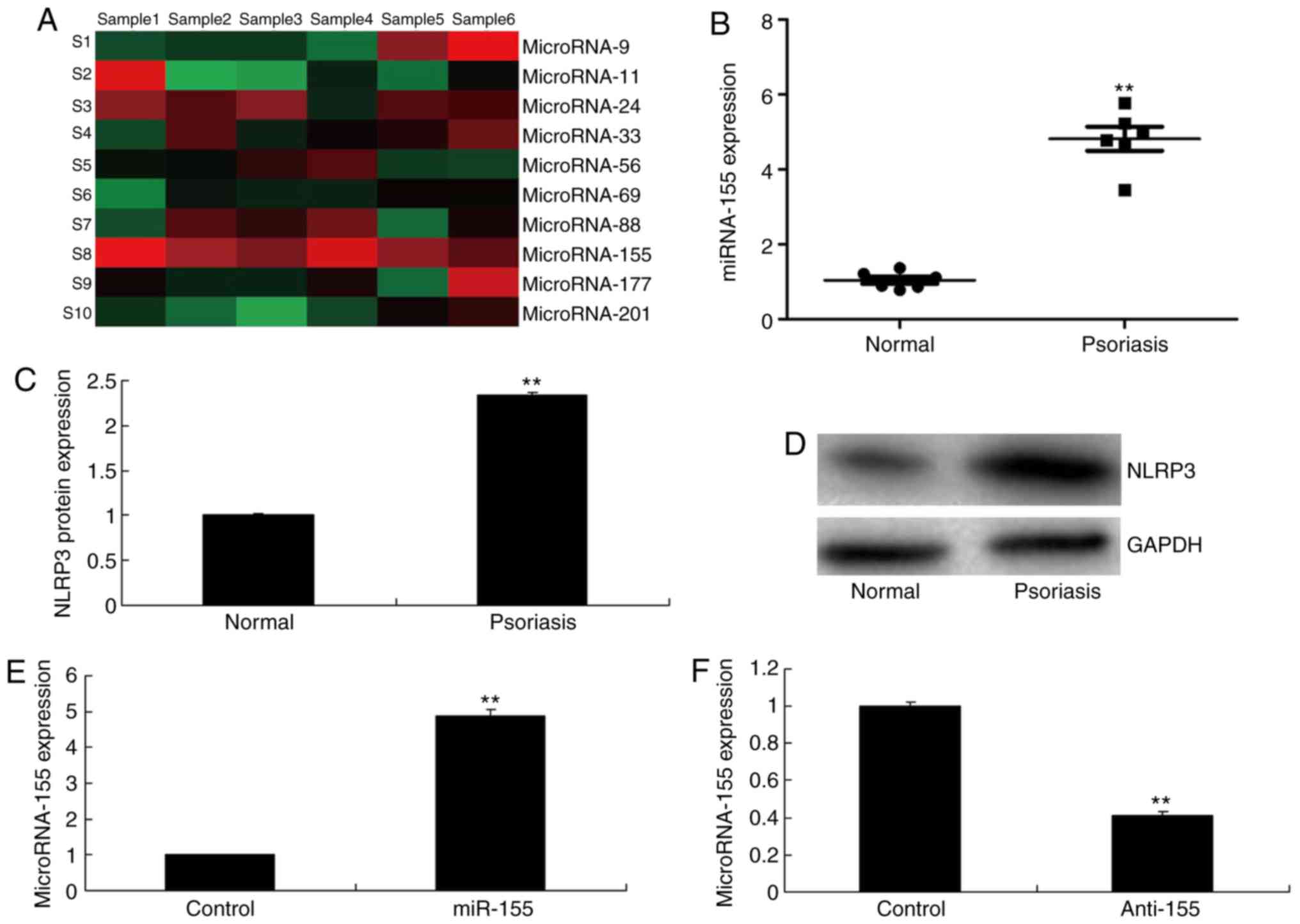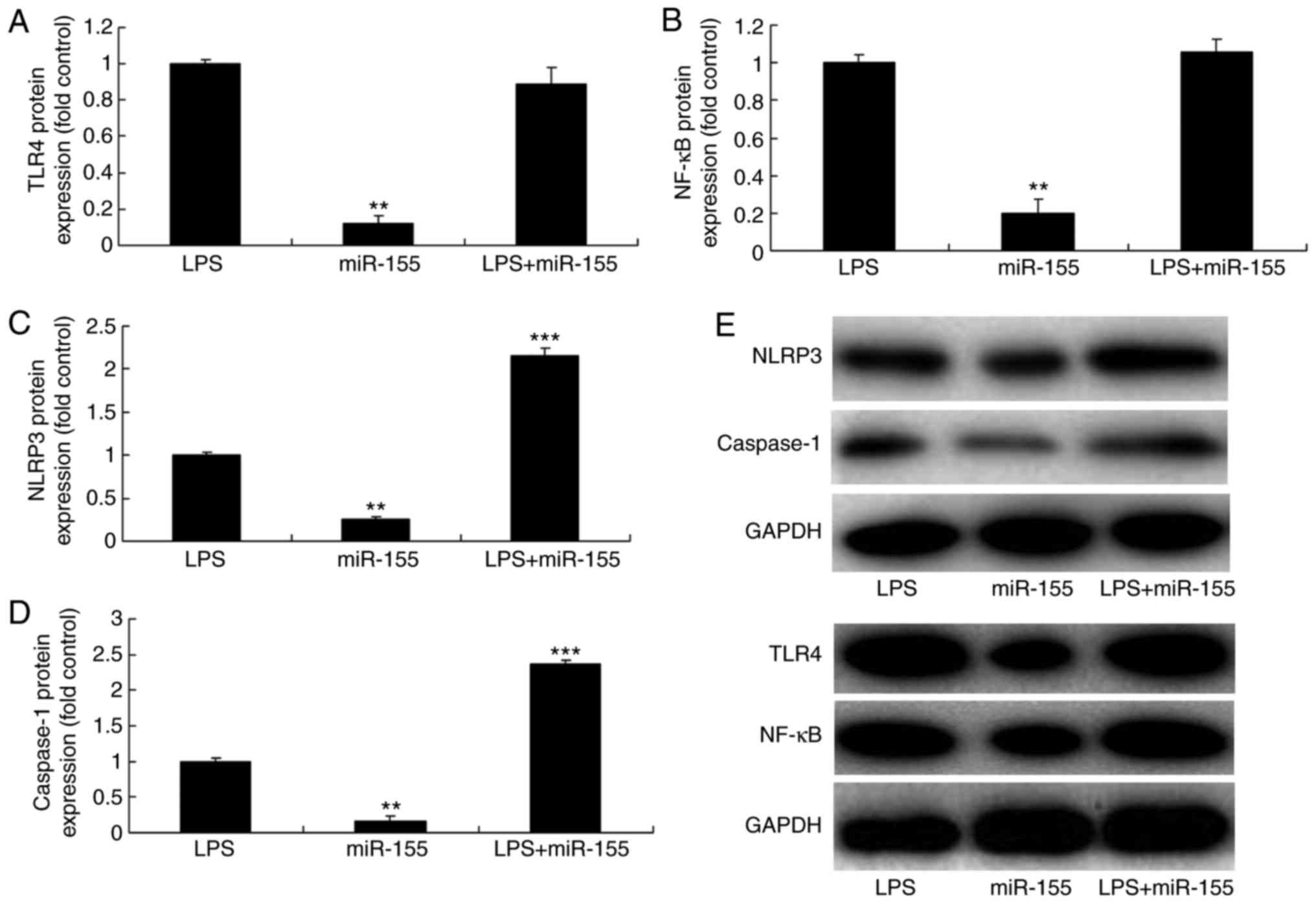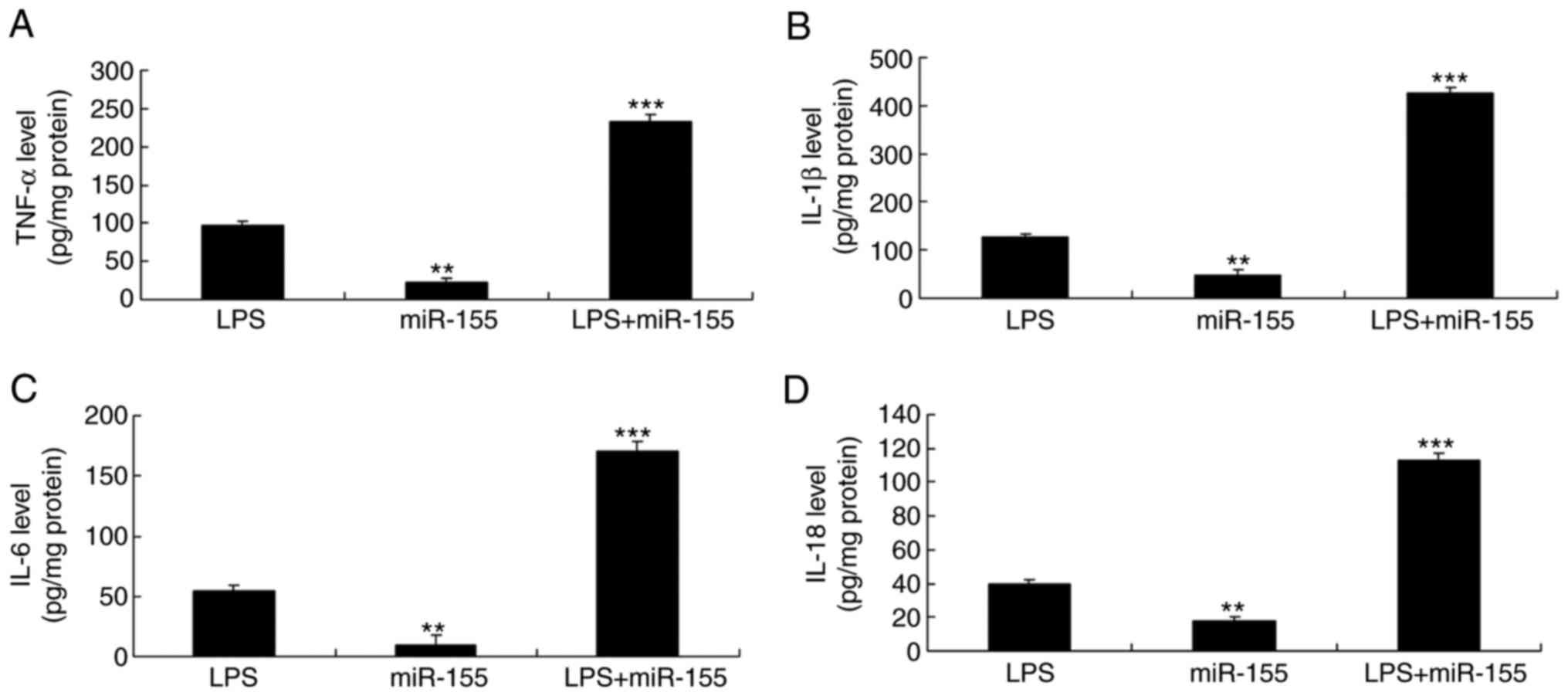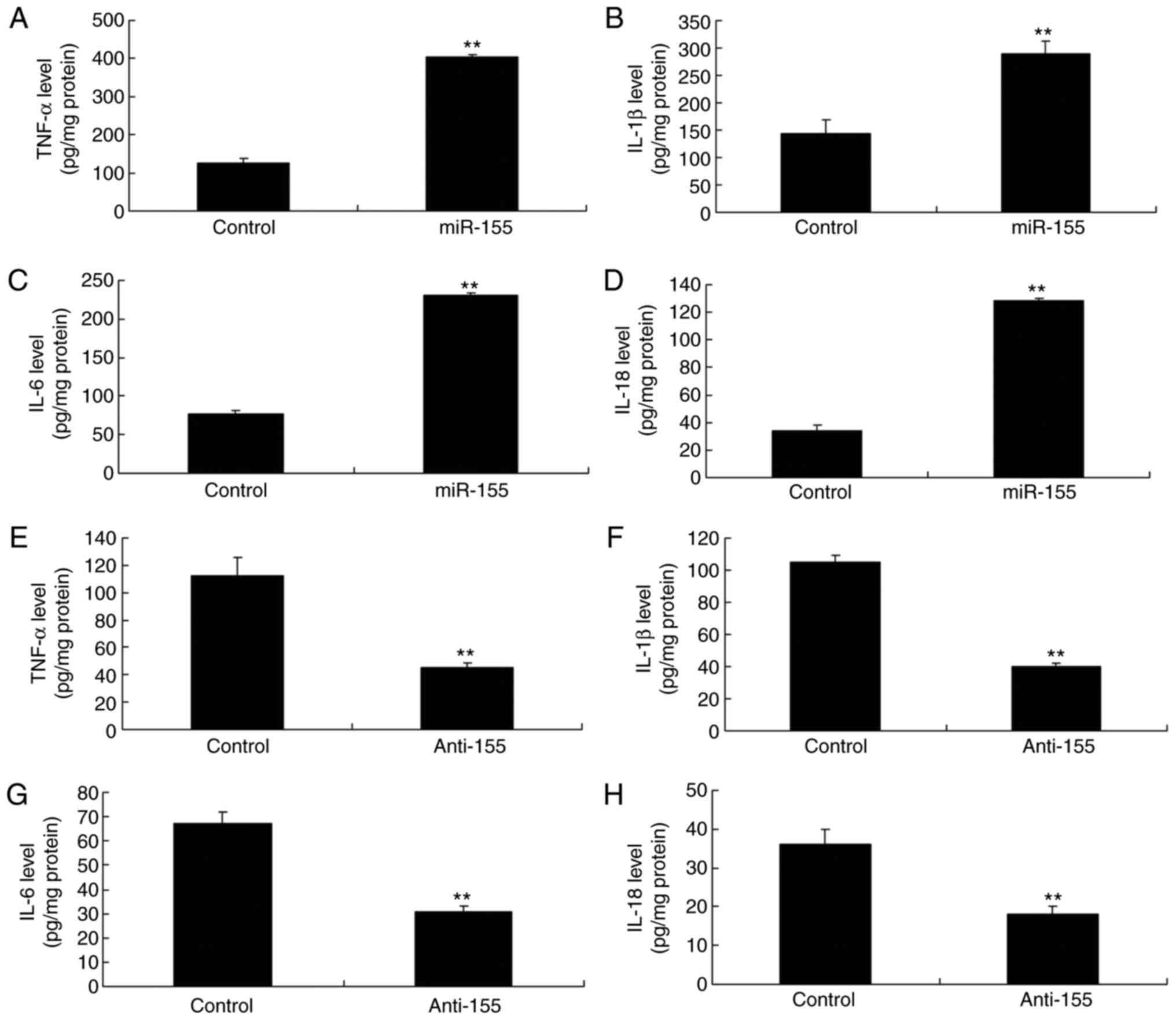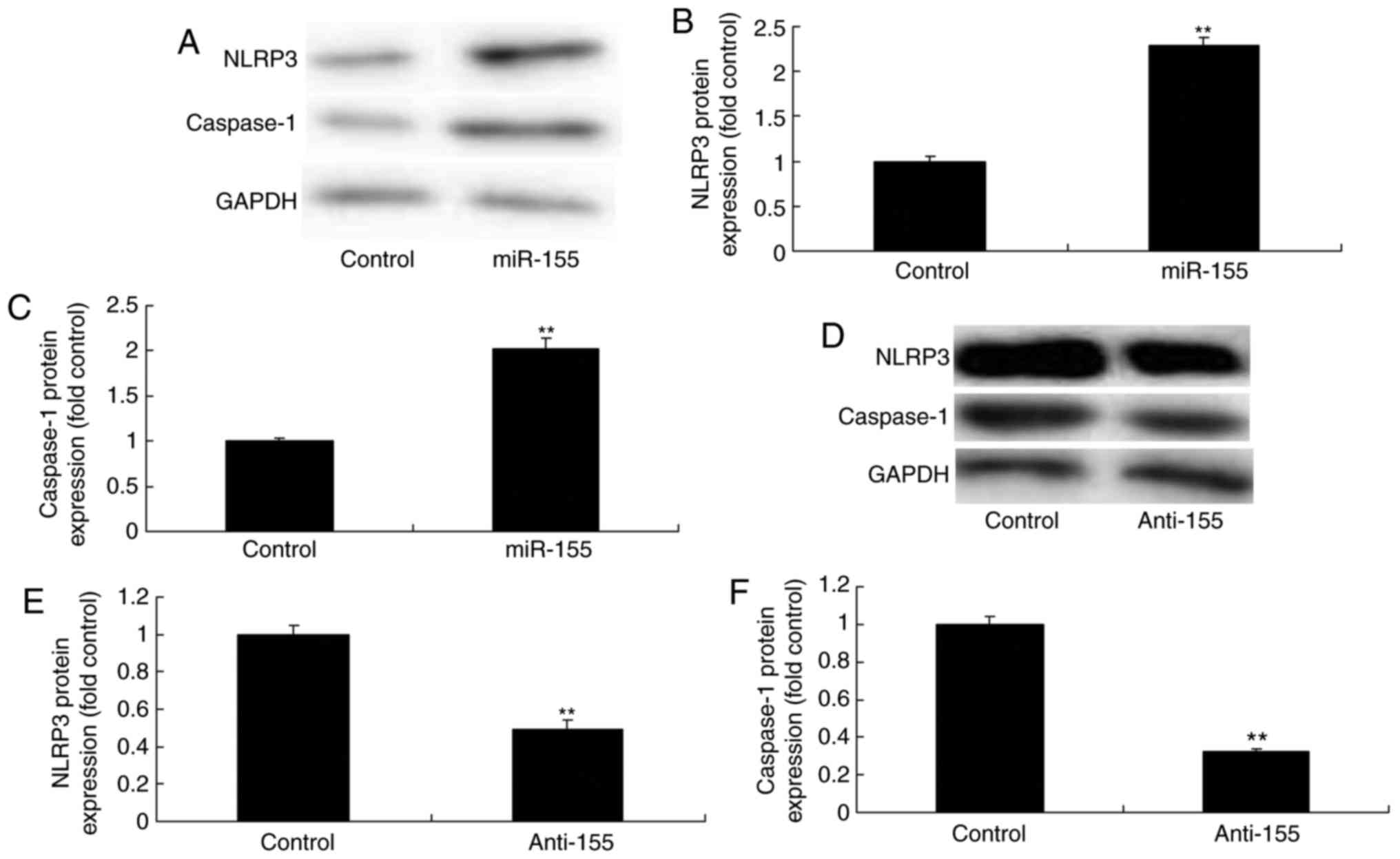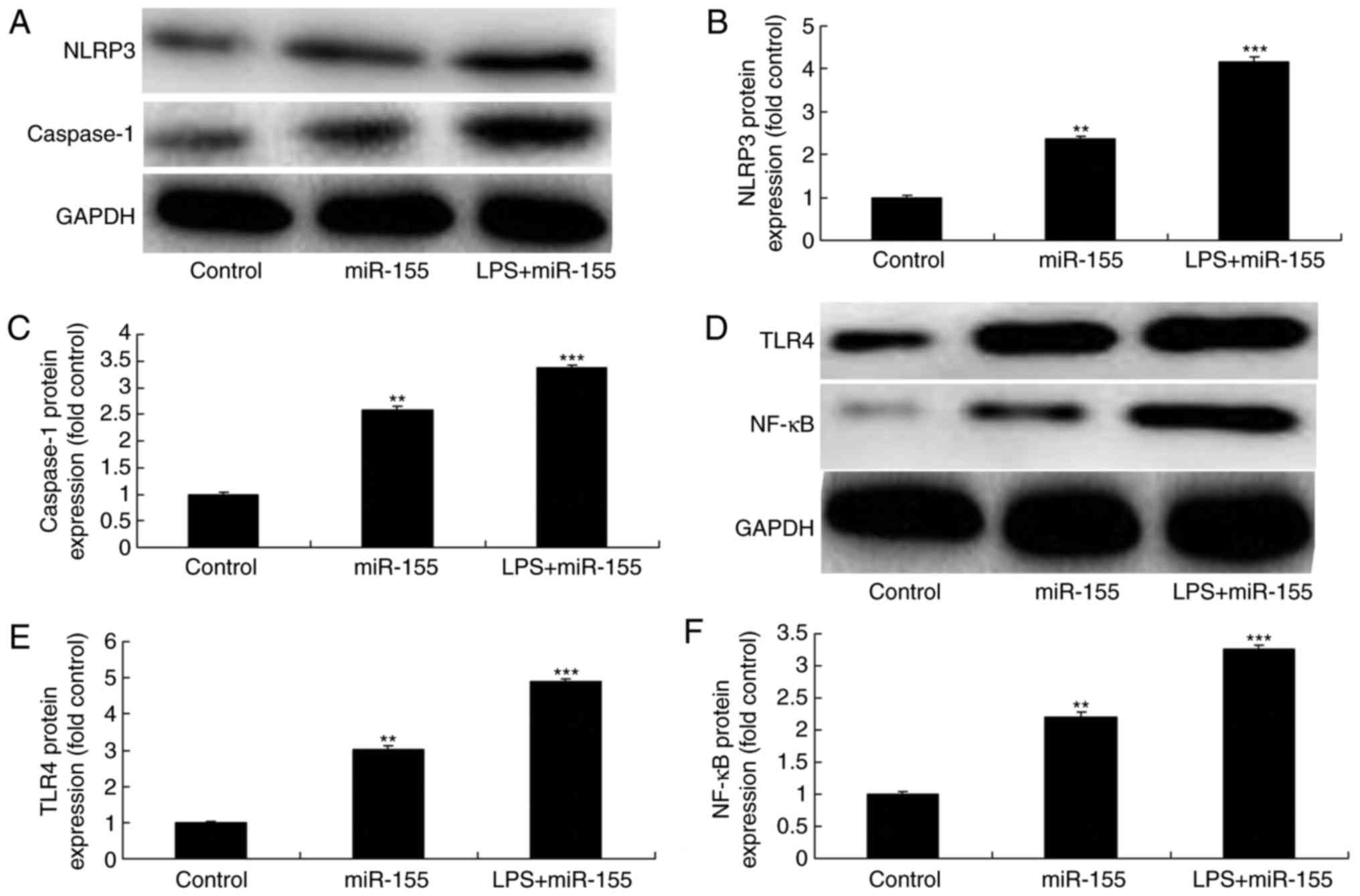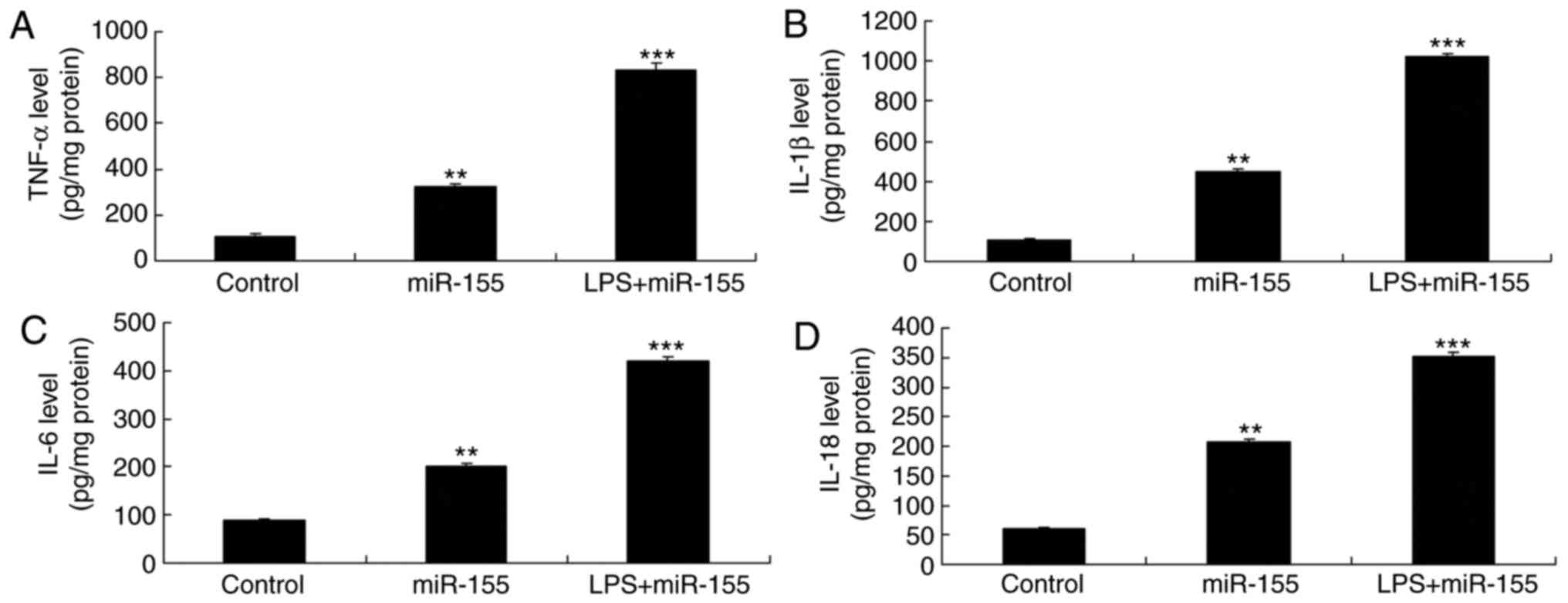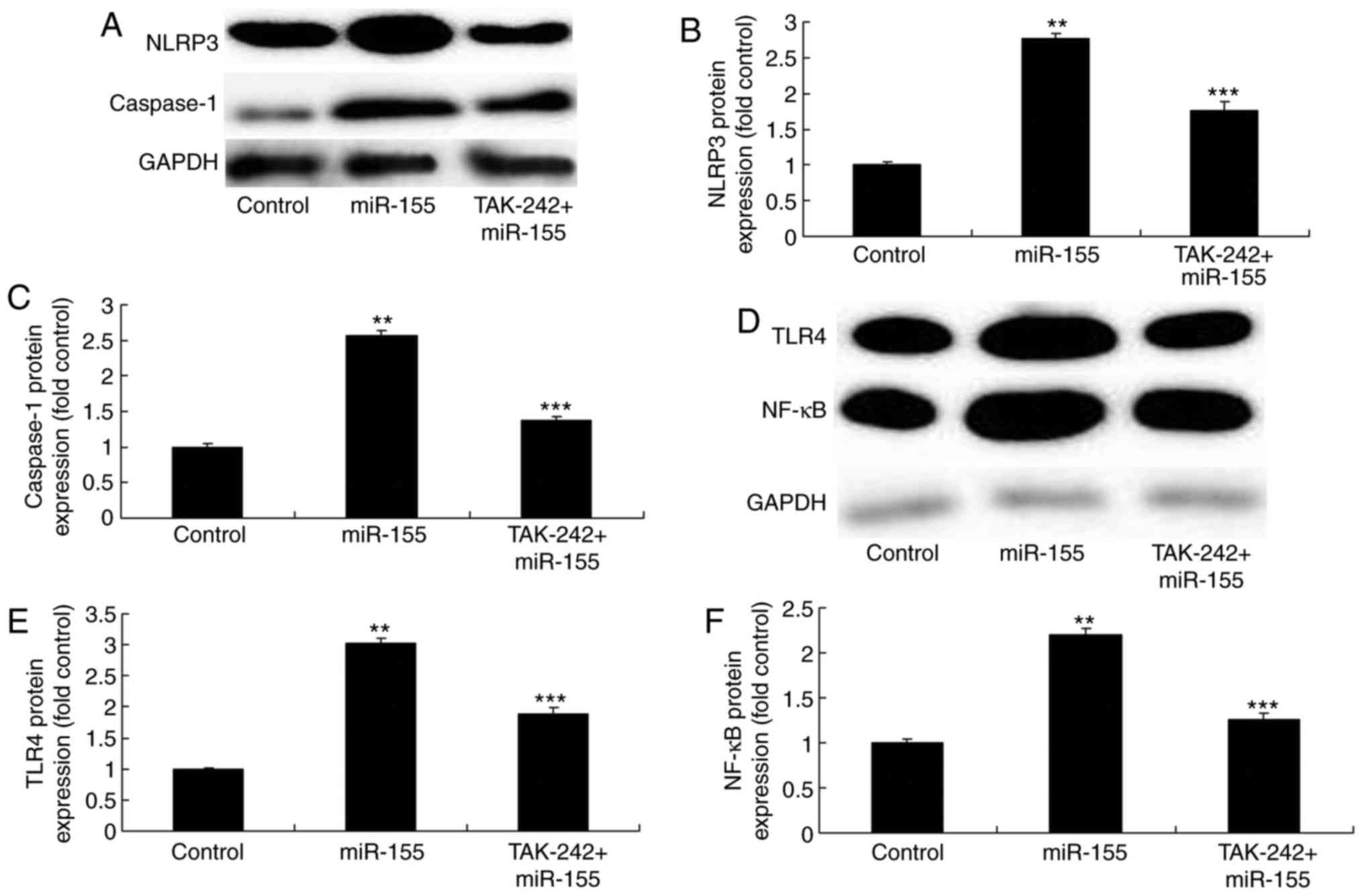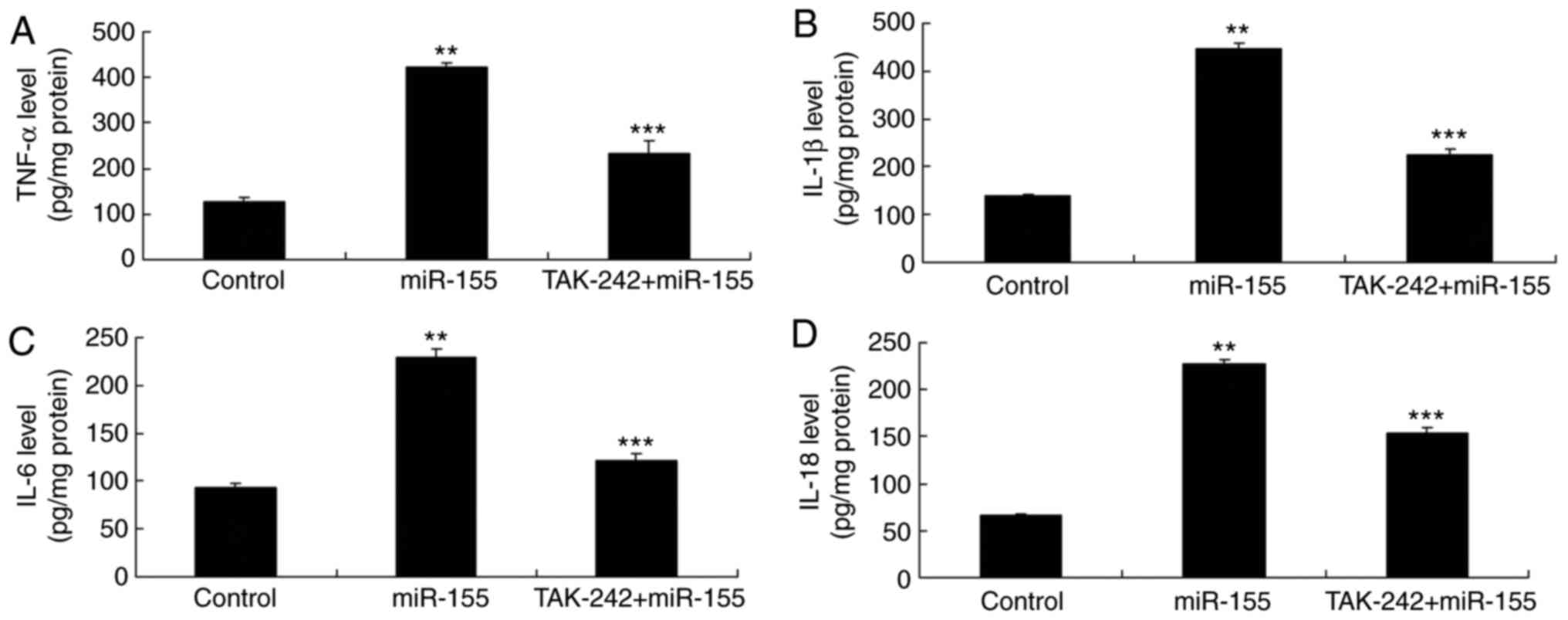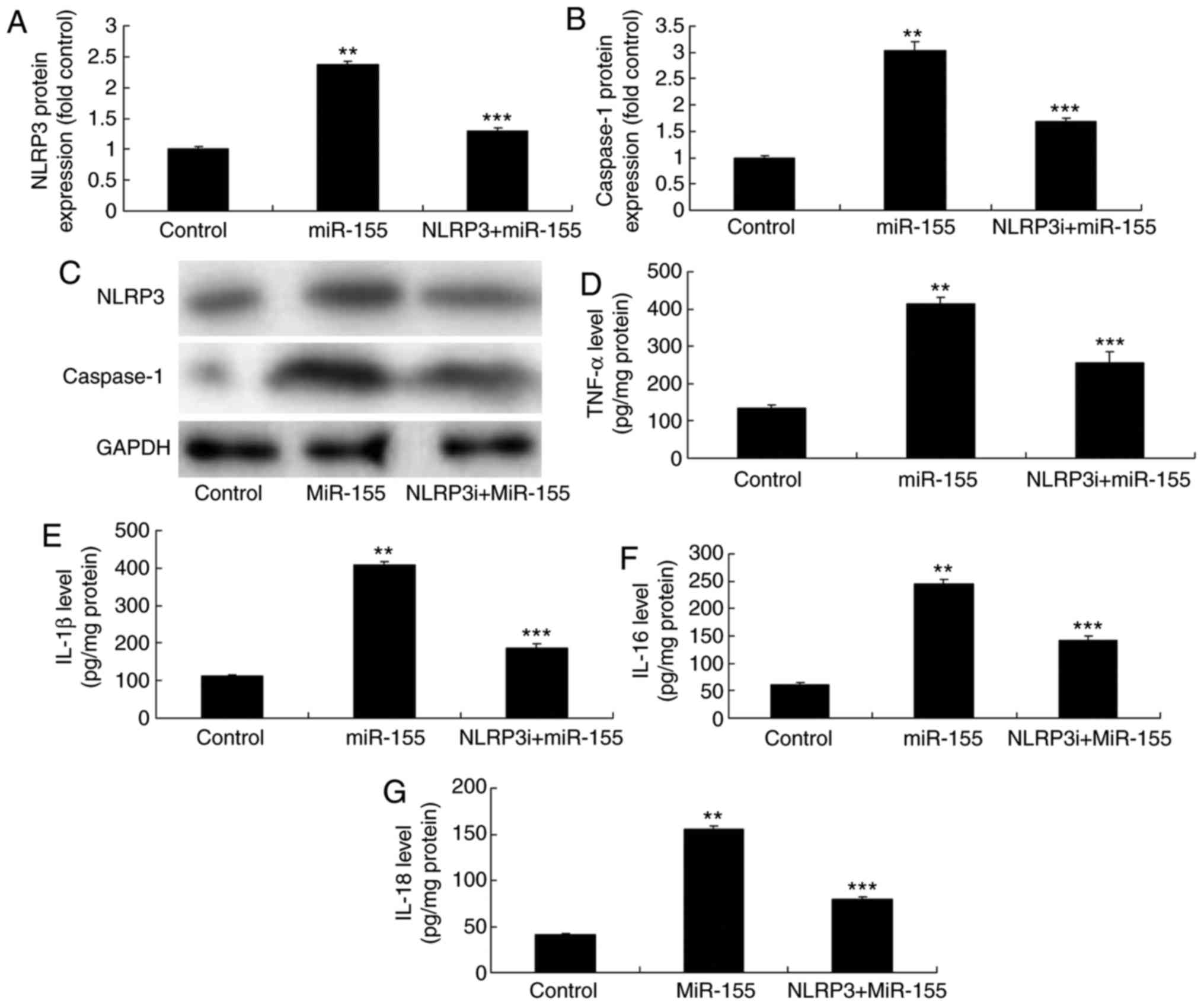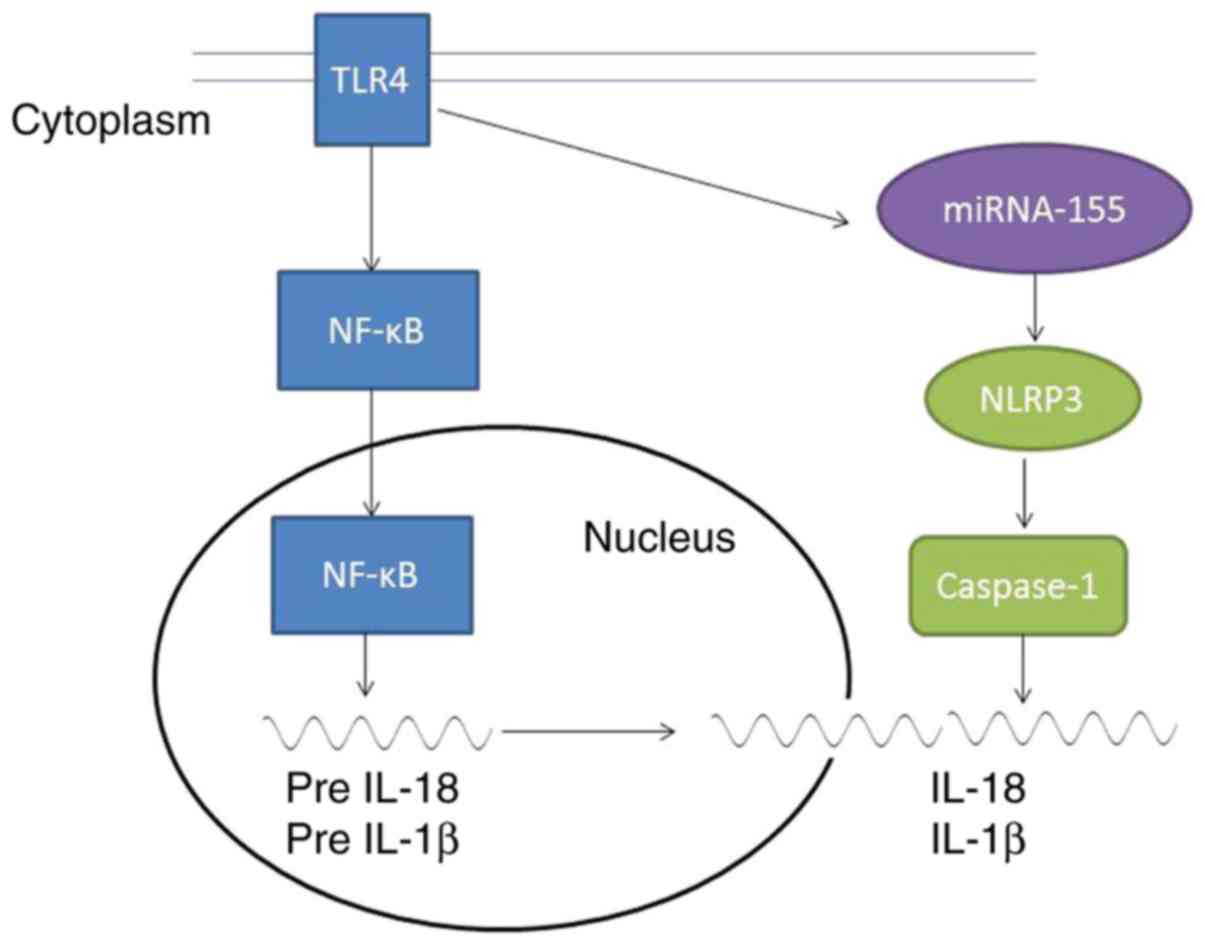Silencing of miR‑155 suppresses inflammatory responses in psoriasis through inflammasome NLRP3 regulation
- Authors:
- Published online on: May 14, 2018 https://doi.org/10.3892/ijmm.2018.3677
- Pages: 1086-1095
Abstract
Introduction
The etiology of psoriasis remains unclear. Modern research has demonstrated that it is related to various factors, including heredity, infection, immunity, spirit, endocrine, trauma, diet and metabolic disorder (1). At present, it is suggested that immune mediation accounts for the major pathogenesis (2). Its clinical manifestation consists of reddish and scaly skin damage, with an initial reddish rash (2). The epidermis is covered by layers of silvery scales, with dry, flaking and crusting skin (2). In addition, several skin symptoms are contiguous. Some may be itching, suppurant and blood-stained. Psoriasis can be classified into Plaque, erythrodermic, pustular, and arthritic types (3). Blood-heat syndrome in traditional Chinese medicine is dominated by papule and maculopapule, where new rash occurs continuously, basal skin is bright red in color, and punctuate hemorrhage can be observed after scraping the scales (4). In addition, it is accompanied with various degrees of itching, which equals to the progressive psoriasis in western medicine. Prospective treatment and future drug therapies have been proposed under the guidance of gradually updated pathogenesis concept (5). Furthermore, more attention has been paid to the complicated pathogenesis inducing the pathological changes of the disease (4). Treatment may not be limited to the traditional antiproliferative, antimetabolic and anti-inflammatory measures based on the cellular morphological changes (1).
MicroRNAs (miRNAs) are derived from the non-coding region of the genome (6). They are a group of evolutionarily conserved single-strand RNAs with length of ~21–24 nucleotides (7). A miRNA can target the mRNA of multiple genes. In addition, the mRNA of a single gene can be simultaneously regulated by multiple miRNAs, suggesting a great diversity and complexity of miRNAs biological activities (7). Research focusing on the regulation of miRNAs in immune responses, as well as their regulatory mechanisms, are currently a hot topic in immunology. The involvement of miRNAs in regulating inflammation, natural immune responses and antiviral immune responses has been reported in numerous studies (7,8).
Previous research has indicated that NLR family pyrin domain containing 3 (NLRP3) can be stimulated by various pathogenic microorganisms (9). In addition, it can be stimulated by multiple pathogen-associated molecular patterns (PAMPs), damage-associated molecular patterns (DAMPS) and environmental factors (9). These mainly include ATP, hyaluronic acid, β-amyloid protein, extracellular glucose, monosodium urate crystal, shoe stone, asbestos, ultraviolet ray, picric acid and dinitrofluorobenzene (10). Additionally, NLRP3 expression has been demonstrated to be increased in multiple diseases, including myocardial infarction, Alzheimer disease, type 2 diabetes and its complications, gouty arthritis, lung disease and dermatitis (11). Toll-like receptor 4 (TLR4) signaling regulates miR-155 to promote liver fibrosis and alcohol-induced steatohepatitis (12). In the present study, it was hypothesized that the function of miR-155 may increase psoriasis-induced inflammation and that its expression may be dependent on inflammasome activation.
Materials and methods
Imiquimod-induced skin-inflammation model
Female BALB/c mice (6 week, 20–22 g, n=12) were purchased from the Center of Laboratory Animal Science of Guangdong (Guangdong, China), and housed at 22–23°C, 55–60% humidity, 12 h light/dark cycle, and freely access to food and water. The mice (n=12) were randomly assigned into two groups: Normal (n=6) and psoriasis model (n=6). In the psoriasis model group, mice were treated on regions of shaved skin with 62.5 mg of 5% imiquimod cream (Aldara; 3M Pharmaceuticals, Maplewood, MN, USA) at 8:00 pm for 7 days. The present study was approved by the Medical Ethics Committee of Guangzhou Institute of Dermatology (Guangzhou, China).
Reverse transcription-quantitative polymerase chain reaction (RT-qPCR) assay and microarray data analysis
Total RNA from skin samples and cells was isolated using TRIzol reagent (Thermo Fisher Scientific, Inc., Waltham, MA, USA). Total RNA was reverse transcribed using 200 ng total RNA with the RevertAid Reverse Transcription kit (Thermo Fisher Scientific, Inc.). qPCR was conducted using a Roche LightCycler 480 PCR machine (Roche Diagnostics, Basel, Switzerland) with the SYBR-Green miScript PCR kit (Qiagen, Inc., Valencia, CA, USA). The reaction conditions were: 95°C for 10 min, followed by 40 cycles of 95°C for 30 sec and 60°C for 30 sec. Primer sequences were as follows: miR-155, forward 5′-TTAATGCTAATCGTGTAGGGG-3′ and reverse 5′-CGAATTCTAGAGCTCGAGGCAGG-3′; U6, forward 5′-CTCGCTTCGGCACA-3′ and reverse 5′-CGAATTCTAGAGCTCGAGGCAGG-3′. mRNA expression was calculated using the formula 2−ΔΔCq (12).
A total of 500 ng total RNA was used for microarray data analysis (8×15 K G4471A-021828 platform) Agilent Technologies, Inc., Santa Clara, CA, USA) (13). Array data was acquired using the Agilent Feature Extraction software (Agilent Technologies, Inc.) according to the manufacturer′s protocols. The GeneSpring GX v12.1 software package (Agilent Technologies, Inc.) was used for quantile normalization and subsequent data processing.
Cell culture and cell transfection
HaCaT cells were cultured at 37°C/5% CO2 in MEM (Sigma-Aldrich; Merck KGaA, Darmstadt, Germany) containing 10% fetal bovine serum (FBS; Thermo Fisher Scientific, Inc.) and antibiotics (Sigma-Aldrich; Merck KGaA). miR-155, forward 5′-GATCCCTGTTAATGCTAATCGTGATAGGGGTTTTTGCCTCCAACTGACTCCTACATATTAGCATTAACAGA-3′, reverse 5′-AGCTTCTGTTAATGCTAATATGTAGGAGTCAGTTGGAGGCAAAAACCCCTATCACGATTAGCATTAACAGG-3′; miR-155 inhibitor, forward 5′-ACCCCUAUCACGAUUAGCAUUAA-3′,reverse5′-ACGUGACACGUUCGGAGAATT-3′; negative control, forward 5′-CCCCCCCCCCCCCCCCCCCC-3′ and reverse 5′-CCCCCCCCCCCCCCCCCCCC-3′. miR-155 mimic, miR-155 inhibitor and negative control oligos were purchased from Sangon Biotech Co., Ltd. (Shanghai, China). miR-155 mimic (100 ng), miR-155 inhibitor (100 ng) and negative control (100 ng) were transfected into cells using Lipofectamine 2000 (Thermo Fisher Scientific, Inc.). Following transfection for 6 h, the medium was removed and fresh medium was added, containing 0.1 ng/ml human interleukin (IL)-4 (Sigma-Aldrich; Merck KGaA), 1 ng/ml human tumor necrosis factor (TNF)-α (Sigma-Aldrich; Merck KGaA) and 10 ng/ml human interferon (IFN)-γ (Sigma-Aldrich; Merck KGaA) for 24 h. Cells were then cultured as keratinocyte-induced HaCaT cells, an in vitro model for psoriasis, as previously reported in the literature (14). Cells were induced with 100 ng/ml LPS (Beyotime Institute of Biotechnology, Jiangsu, China) for 24 h. Cells were treated with NLRP3 inhibitor, MCC950 (2 nM; MedChemExpress, Shanghai, China) for 8 h.
ELISA
Following culture of the in vitro model of psoriasis for 8 h, the culture supernatant was centrifuged at 2,000 × g for 10 min at 4°C and TNF-α (H052), IL-18 (H015), IL-6 (H007) and IL-1β (H002) levels were quantified with a ELISA kits (Nanjing Jiancheng Biology Engineering Institute, Nanjing, China). Absorbency was detected at 450 nm using an AIA 600II Automated Enzyme Immunoassay Analyzer (Tosoh Corporation, Tokyo, Japan).
Western blot analysis
Following culture of the in vitro model of psoriasis for 8 h, cells were lysed with RIPA buffer (Beyotime Institute of Biotechnology) and protein concentration was quantified using a bicinchoninic acid protein assay kit (Beyotime Institute of Biotechnology). A total of 50 μg proteins were separated using 8–12% SDS-PAGE gels and blotted onto a polyvinylidene difluoride membrane (Life Technologies, Grand Island, NY, USA). The membrane was blocked with 5% non-fat dried milk for 1 h at 37°C and then probed with antibodies against TLR4 (1:1,000; sc-10741; Santa Cruz Biotechnology, Inc., Dallas, TX, USA), NF-κB (1:1,000; sc-109, Santa Cruz Biotechnology, Inc.), NLRP3 (1:1,000; sc-66846, Santa Cruz Biotechnology), caspase-1 (1:1,000; sc-514, Santa Cruz Biotechnology, Inc.) and GAPDH (1:5,000; sc-25778, Santa Cruz Biotechnology, Inc.) overnight at 4°C. Following three washes with PBST, the PVDF membrane was incubated with goat anti-rabbit horseradish peroxidase-conjugated secondary antibody (1:5,000; 7074, Cell Signaling Technology, Inc., Danvers, MA, USA) for 1 h at 37°C. Signals were developed using an enhanced chemiluminescence kit (Thermo Fisher Scientific, Inc.) and protein expression was quantified using Image-Pro Plus software version 6.0 (Media Cybernetics, Inc., Rockville, MD, USA).
Statistical analysis
Data are expressed as the mean ± standard deviation from three independent repeats. Statistical analyses were performed by one-way analysis of variance following by a Tukey post-hoc test using SPSS 17.0 (SPSS, Inc., Chicago, IL, USA). P<0.05 was considered to indicate a statistically significant difference.
Results
miR-155 expression in psoriasis
The expression of miR-155 in psoriasis was first examined by using gene chip and qPCR analyses. In the in vivo model of psoriasis, miR-155 expression levels were significantly increased in psoriasis tissues compared with normal tissues (Fig. 1A and B). Notably, the protein expression levels of NLRP3 were also significantly induced in the in vivo psoriasis model group, compared with the control group (Fig. 1C and D). Based on these initial experiments, it was hypothesized that miR-155 may promote psoriasis by modifying gene expression. Then, miR-155 mimics increased the expression of miR-155, and anti-miR-155 mimics decreased the expression of miR-155 in vitro model (Fig. 1E and F).
Effects of miR-155 on the inflammatory response of lipopolysaccharide (LPS)-induced HaCaT cells
Next, LPS was used to induce HaCaT cells and a mimic was used to overexpress miR-155. The results demonstrated that the protein expression levels of TLR4, nuclear factor (NF)-κB, NLRP3 and caspase-1 were lower in the miR-155 overexpression alone group compared with the LPS group (Fig. 2). The protein expression of TLR4 and NF-κB in the miR-155 overexpression and LPS groups was similar to those of the LPS alone group (Fig. 2A, B, and E). However, the protein expression of NLRP3 and caspase-1 in the miR-155 overexpression and LPS group was higher compared with the LPS alone group (Fig. 2C–E). In addition, the levels of secreted TNF-α, IL-18, IL-6 and IL-1β in the culture supernatant of the miR-155 overexpression alone group were lower compared with the LPS group (Fig. 3). However, the levels of secreted TNF-α, IL-18, IL-6 and IL-1β levels in the miR-155 overexpression and LPS group were higher than those of the LPS alone group (Fig. 3). These results suggested that miR-155 regulated the inflammasome NLRP3 activation, but did not affect the TLR4/NF-κB signaling pathway.
Effects of miR-155 expression on inflammation
Then, the in vitro psoriasis model of keratinocyte-induced HaCaT cells was used to either upregulate or silence miR-155 expression by transfecting a mimic or an inhibitor, respectively (Fig. 1E, F). Overexpression of miR-155 significantly increased TNF-α, IL-18, IL-6 and IL-1β levels (Fig. 4A–D). By contrast, silencing of miR-155 significantly decreased TNF-α, IL-18, IL-6 and IL-1β levels in keratinocyte-induced HaCaT cells (Fig. 4E–H).
miR-155 regulates the NLRP3/caspase-1 signaling pathway
To examine the potential mechanism by which miR-155 may mediate inflammation in psoriasis, the expression levels of proteins in the NLRP3/caspase-1 pathway were measured. As illustrated in Fig. 5, overexpression of miR-155 significantly enhanced NLRP3 and caspase-1 protein expression, while miR-155 silencing significantly suppressed NLRP3 and caspase-1 protein expression in keratinocyte-induced HaCaT cells.
Activation of TLR4 by LPS stimulation enhancess miR-155-mediated inflammation in keratinocyte-induced HaCaT cells
Bala et al (15) have demonstrated that TLR4 signaling regulates miR-155 to promote liver fibrosis and alcohol-induced steatohepatitis. To directly examine the upstream pathways of miR-155 in psoriasis-related inflammation, the TLR4/NF-κB signaling pathway was analyzed. NLRP3 and caspase-1 protein expression levels were significantly increased by LPS stimulation and miR-155 overexpression, compared with the miR-155 overexpression alone group (Fig. 6A–C). In addition, TLR4 and NF-κB protein expression levels were significantly induced by LPS stimulation and miR-155 overexpression, compared with the miR-155 overexpression alone group (Fig. 6D–F) Furthermore, LPS stimulation, and subsequently activation of TLR4, enhanced the miR-155-mediated increase in the secreted levels of TNF-α, IL-18, IL-6 and IL-1β in miR-155-overexpressing keratinocyte-induced HaCaT cells, compared with the miR-155 overexpression alone group (Fig. 7).
Inhibition of TLR4 reverses the miR-155-mediated inflammation in keratinocyte-induced HaCaT cells
The TLR4 inhibitor, TAK-242, was added in the cells at 2 nM for 8 h to inhibit TLR4 activation. The results demonstrated that TLR4 inhibition suppressed the NLRP3 and caspase-1 protein expression levels in miR-155 overexpressing keratinocyte-induced HaCaT cells, compared with the miR-155 overexpression alone group (Fig. 8A–C). Similarly, inhibition of TLR4 reduced the miR-155-mediated upregulation of TLR4 and NF-κB, compared with the miR-155 overexpression alone group (Fig. 8D–F). In addition, inhibition of TLR4 reversed the miR-155-mediated increase in the secreted levels of TNF-α, IL-18, IL-6 and IL-1β in keratinocyte-induced HaCaT cells, compared with the miR-155 overexpression alone group (Fig. 9).
Inhibition of NLRP3 reverses the miR-155-mediated inflammation in vitro
Finally, the hypothesis that miR-155-induced regulation of inflammation-related genes may occur through NLRP3 was examined. The NLRP3 inhibitor, MCC950 (2 nM for 8 h), was added to the cells, and protein expression was analyzed by western blotting. Addition of the NLRP3 inhibitor suppressed NLRP3 and caspase-1 protein expression levels in the in vitro psoriasis model, compared with the miR-155 overexpression alone group (Fig. 10A–C). Additionally, the miR-155 overexpression-induced TNF-α, IL-18, IL-6 and IL-1β levels were significantly reduced in the in vitro keratinocyte model following NLRP3 inhibition, compared with the miR-155 overexpression alone group (Fig. 10D–G).
Discussion
Neurodermatitis, which is part of the cancer category in traditional Chinese medicine, is referred to as psoriasis. It is characterized by its refractoriness. Psoriasis has gained names such as cowhide carcinoma and incised wound, according to different skin lesion morphologies (5,16). Psoriasis is the most common chronic, recurrent and inflammatory dermatosis characterized by scaly erythema (2). It is the most common refractory disease in skin, with a morbidity of ~0.1–3% (3). In China, the morbidity in the north is higher compared with the south, in urban areas is higher compared with rural areas, and in males is higher compared with females. According to incomplete statistics, the morbidity of psoriasis in China is over 2 million (16). However, the urban population in China is surging in recent years, and China has witnessed an annual new population of 20 million (5). Epidemiological statistics suggest that ~0.1 million psoriasis patients have increased in China every year. The present results clearly demonstrate that miR-155 and NLRP3 expression were significantly increased in psoriasis in vivo and in vitro models compared with control groups.
miRNAs are extensively distributed in nematode, fruit fly and multiple human tissues and cells (6). It is a type of single-strand non-coding RNA with a length of ~21–25 nucleotides (6). miRNAs can bind at the 3′-untranslated region of mRNA, and negatively regulate the expression of related proteins (6). Numerous previous studies have indicated that miRNAs are closely related to inflammation (6,15). They predominantly target important proteins in the NLRP3 inflammation-associated pathway, thus promoting or inhibiting the inflammatory response (17). The present study demonstrated that overexpression of miR-155 significantly increased TNF-α, IL-18, IL-6 and IL-1β levels in keratinocyte-induced HaCaT cells, through the NLRP3 inflammasome. Obora et al (18) described that inflammation-induced miR-155 inhibits self-renewal of neural stem cells. However, it remains to be elucidated how miR-155 regulates NLRP3 in psoriasis.
The NLRP3 inflammasome is constituted by NLRP3, the apoptosis-associated speck-like protein containing CARD (ASC), and the cysteinyl aspartate specific proteinase-1, caspase-1 (19). NLRP3 binds to ASC once it is activated (11), and then it can recruit pro-caspase-1 and induce its self-cleavage to produce the activated caspase-1 (19). The activated caspase-1 can cleave the pro-IL-1β into active IL-1β, thus activating the downstream inflammatory response (20). The present results demonstrated that TLR4 induced the miR-155/NLRP3 inflammasome in keratinocyte-induced HaCaT cells. Bala et al (15) reported that TLR4 signaling regulates miR-155 to promote liver fibrosis and alcohol-induced steatohepatitis. Taken together, these data suggest that TLR4 signaling regulates miR-155-induced inflammation through NLRP3 inflammasome in psoriasis.
The NLRP3 inflammasome-activated molecular mechanism is extremely complicated, and it can be classified into three major pathways (21). In the first pathway, extracellular ATP stimulates the opening of the P2X7-dependent ion channel (21). This can promote K+ outflow and the formation of the pannexin-1 membrane channel. Thus, the extracellular NLRP3 agonist can enter the cell and directly promote the aggregation and activation of the NLRP3 inflammasome (20). NLRP3 inflammasome enhances the production of effector molecules, such as caspase-1 and IL-1p. NF-κB in macrophages can upregulate NLRP3 expression (20). Intracellular inflammatory factors, such as IL-1β, can also be released out of the cell, thus inducing inflammatory response (22). In the present study, addition of an NLRP3 inhibitor reversed the miR-155 mediated increased inflammation in keratinocyte-induced HaCaT cells. Artlett et al (23) reported that miR-155 required NLRP3 inflammasome-mediated collagen synthesis during fibrosis.
The present data imply that TRL4/miR-155 increased inflammatory responses in psoriasis through inflammasome NLRP3 activation. TLR4/NF-κB signaling induced inflammation and miR-155/NLRP3/caspase-1 promoted the production of IL-18 and IL-1β in psoriasis (Fig. 11). Further studies targeting miR-155 may provide new prospects in discovering the causative factors involved in psoriasis and reveal novel strategies for psoriasis treatment.
Acknowledgments
Not applicable.
Funding
No funding was received.
Availability of data and materials
The analyzed data sets generated during the study are available from the corresponding author on reasonable request.
Authors' contributions
XZ designed the experiment; QL, JZ, WL, L L, XZ, XT, WL, LZ performed the experiment; XZ and QL analyzed the data; XZ wrote the manuscript.
Ethics approval and consent to participate
The present study was approved by the Medical Ethics Committee of Guangzhou Institute of Dermatology (Guangzhou, China).
Consent for publication
Not applicable.
Competing interests
The authors declare that they have no competing interests.
References
|
Reich K, Armstrong AW, Foley P, Song M, Wasfi Y, Randazzo B, Li S, Shen YK and Gordon KB: Efficacy and safety of gusel-kumab, an anti-interleukin-23 monoclonal antibody, compared with adalimumab for the treatment of patients with moderate to severe psoriasis with randomized withdrawal and retreatment: Results from the phase III, double-blind, placebo- and active comparator-controlled VOYAGE 2 trial. J Am Acad Dermatol. 76:418–431. 2017. View Article : Google Scholar : PubMed/NCBI | |
|
Balak DM, van Doorn MB, Arbeit RD, Rijneveld R, Klaassen E, Sullivan T, Brevard J, Thio HB, Prens EP, Burggraaf J and Rissmann R: IMO-8400, a toll-like receptor 7, 8, and 9 antagonist, demonstrates clinical activity in a phase 2a, randomized, placebo-controlled trial in patients with moderate-to-severe plaque psoriasis. Clin Immunol. 174:63–72. 2017. View Article : Google Scholar | |
|
Hayashi M, Umezawa Y, Fukuchi O, Ito T, Saeki H and Nakagawa H: Efficacy and safety of ustekinumab treatment in elderly patients with psoriasis. J Dermatol. 41:974–980. 2014. View Article : Google Scholar : PubMed/NCBI | |
|
Zhao L, Chen X, Cai L, Zhang C, Wang Q, Jing S, Chen G, Li J, Zhang J and Fang Y: Randomized, double-blind, placebo-controlled, multiple-dose study of the safety, tolerability and pharmacokinetics of benvitimod, a candidate drug for the treatment of psoriasis. J Clin Pharm Ther. 39:418–423. 2014. View Article : Google Scholar : PubMed/NCBI | |
|
Yao DN, Lu CJ, Wen ZH, Yan YH, Xuan ML, Li XY, Li G, He ZH, Xie XL, Deng JW, et al: Oral PSORI-CM01, a Chinese herbal formula, plus topical sequential therapy for moderate-to-severe psoriasis vulgaris: Pilot study for a double-blind, randomized, placebo-controlled trial. Trials. 17:1402016. View Article : Google Scholar : PubMed/NCBI | |
|
Liu Q, Wu DH, Han L, Deng JW, Zhou L, He R, Lu CJ and Mi QS: Roles of microRNAs in psoriasis: Immunological functions and potential biomarkers. Exp Dermatol. 26:359–367. 2017. View Article : Google Scholar | |
|
Li Y, Su J, Li F, Chen X and Zhang G: miR-150 regulates human keratinocyte proliferation in hypoxic conditions through targeting HIF-1alpha and VEGFA: Implications for psoriasis treatment. PLoS One. 12:e01754592017. View Article : Google Scholar | |
|
Yu X, An J, Hua Y, Li Z, Yan N, Fan W and Su C: MicroRNA-194 regulates keratinocyte proliferation and differentiation by targeting Grainyhead-like 2 in psoriasis. Pathol Res Pract. 213:89–97. 2017. View Article : Google Scholar : PubMed/NCBI | |
|
Dupaul-Chicoine J, Arabzadeh A, Dagenais M, Douglas T, Champagne C, Morizot A, Rodrigue-Gervais IG, Breton V, Colpitts SL, Beauchemin N and Saleh M: The Nlrp3 inflammasome suppresses colorectal cancer metastatic growth in the liver by promoting natural killer cell tumoricidal activity. Immunity. 43:751–763. 2015. View Article : Google Scholar : PubMed/NCBI | |
|
Orlowski GM, Sharma S, Colbert JD, Bogyo M, Robertson SA, Kataoka H, Chan FK and Rock KL: Frontline science: Multiple cathepsins promote inflammasome-independent, particle-induced cell death during NLRP3-dependent IL-1β activation. J Leukoc Biol. 102:7–17. 2017. View Article : Google Scholar : PubMed/NCBI | |
|
Yuan C, Liu C, Wang T, He Y, Zhou Z, Dun Y, Zhao H, Ren D, Wang J, Zhang C and Yuan D: Chikusetsu saponin IVa ameliorates high fat diet-induced inflammation in adipose tissue of mice through inhibition of NLRP3 inflammasome activation and NF-kappaB signaling. Oncotarget. 8:31023–31040. 2017.PubMed/NCBI | |
|
Livak KJ and Schmittgen TD: Analysis of relative gene expression data using real-time quantitative PCR and the 2(−Delta Delta C(T)) method. Methods. 25:402–408. 2001. View Article : Google Scholar | |
|
Maegdefessel L, Spin JM, Raaz U, Eken SM, Toh R, Azuma J, Adam M, Nakagami F, Heymann HM, Chernogubova E, et al: Erratum: miR-24 limits aortic vascular inflammation and murine abdominal aneurysm development. Nat Commun. 6:65062015. View Article : Google Scholar : PubMed/NCBI | |
|
Huang L, Cao J, Cao L, Gao L, Yang Y and Xu L: Puerarin induces cell apoptosis in human chondrosarcoma cell line SW1353 via inhibition of the PI3K/Akt signaling pathway. Oncol Lett. 14:5585–5590. 2017.PubMed/NCBI | |
|
Bala S, Csak T, Saha B, Zatsiorsky J, Kodys K, Catalano D, Satishchandran A and Szabo G: The pro-inflammatory effects of miR-155 promote liver fibrosis and alcohol-induced steatohepatitis. J Hepatol. 64:1378–1387. 2016. View Article : Google Scholar : PubMed/NCBI | |
|
Gottlieb A, Sullivan J, van Doorn M, Kubanov A, You R, Parneix A, Hugot S and Milutinovic M: Secukinumab shows significant efficacy in palmoplantar psoriasis: Results from GESTURE, a randomized controlled trial. J Am Acad Dermatol. 76:70–80. 2017. View Article : Google Scholar | |
|
Zhao M, Wang LT, Liang GP, Zhang P, Deng XJ, Tang Q, Zhai HY, Chang CC, Su YW and Lu QJ: Up-regulation of microRNA-210 induces immune dysfunction via targeting FOXP3 in CD4(+) T cells of psoriasis vulgaris. Clin Immunol. 150:22–30. 2014. View Article : Google Scholar | |
|
Obora K, Onodera Y, Takehara T, Frampton J, Hasei J, Ozaki T, Teramura T and Fukuda K: Inflammation-induced miRNA-155 inhibits self-renewal of neural stem cells via suppression of CCAAT/enhancer binding protein β (C/EBPβ) expression. Sci Rep. 7:436042017. View Article : Google Scholar | |
|
Hoyt LR, Randall MJ, Ather JL, DePuccio DP, Landry CC, Qian X, Janssen-Heininger YM, van der Vliet A, Dixon AE, Amiel E and Poynter ME: Mitochondrial ROS induced by chronic ethanol exposure promote hyper-activation of the NLRP3 inflammasome. Redox Biol. 12:883–896. 2017. View Article : Google Scholar : PubMed/NCBI | |
|
Lv Z, Wei Z, Zhang Z, Li C, Shao Y, Zhang W, Zhao X, Li Y, Duan X and Xiong J: Characterization of NLRP3-like gene from Apostichopus japonicus provides new evidence on inflammation response in invertebrates. Fish Shellfish Immunol. 68:114–123. 2017. View Article : Google Scholar : PubMed/NCBI | |
|
Carlström M, Ekman AK, Petersson S, Söderkvist P and Enerbäck C: Genetic support for the role of the NLRP3 inflammasome in psoriasis susceptibility. Exp Dermatol. 21:932–937. 2012. View Article : Google Scholar : PubMed/NCBI | |
|
Irrera N, Vaccaro M, Bitto A, Pallio G, Pizzino G, Lentini M, Arcoraci V, Minutoli L, Scuruchi M, Cutroneo G, et al: BAY 11-7082 inhibits the NF-kappaB and NLRP3 inflammasome pathways and protects against IMQ-induced psoriasis. Clin Sci (Lond). 131:487–498. 2017. View Article : Google Scholar | |
|
Artlett CM, Sassi-Gaha S, Hope JL, Feghali-Bostwick CA and Katsikis PD: mir-155 is overexpressed in systemic sclerosis fibroblasts and is required for NLRP3 inflammasome-mediated collagen synthesis during fibrosis. Arthritis Res Ther. 19:1442017. View Article : Google Scholar : PubMed/NCBI |



